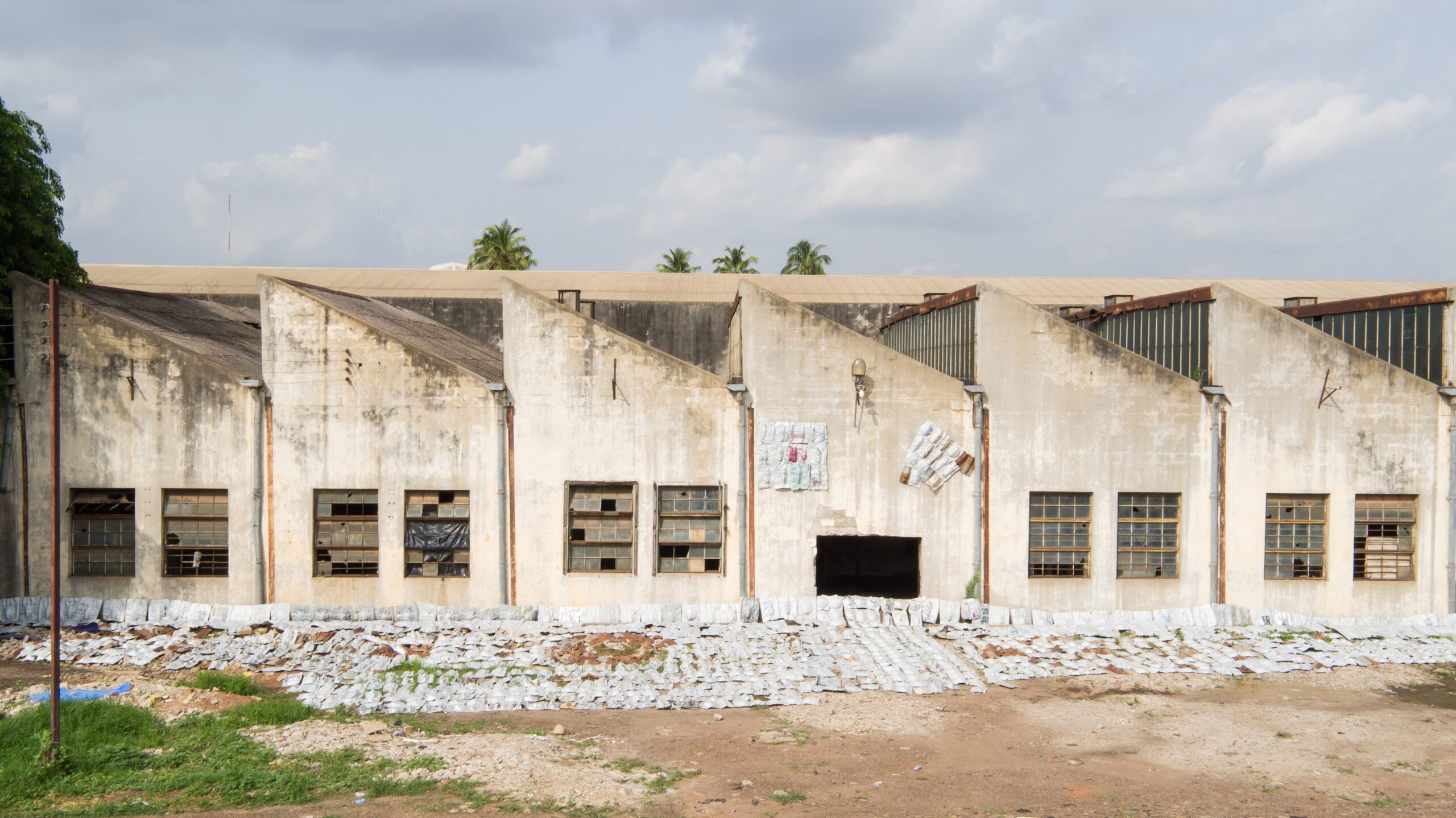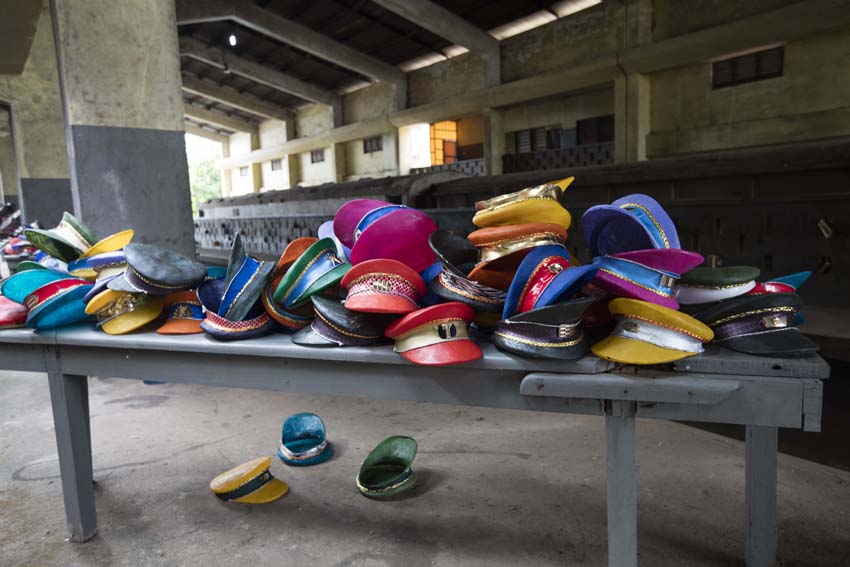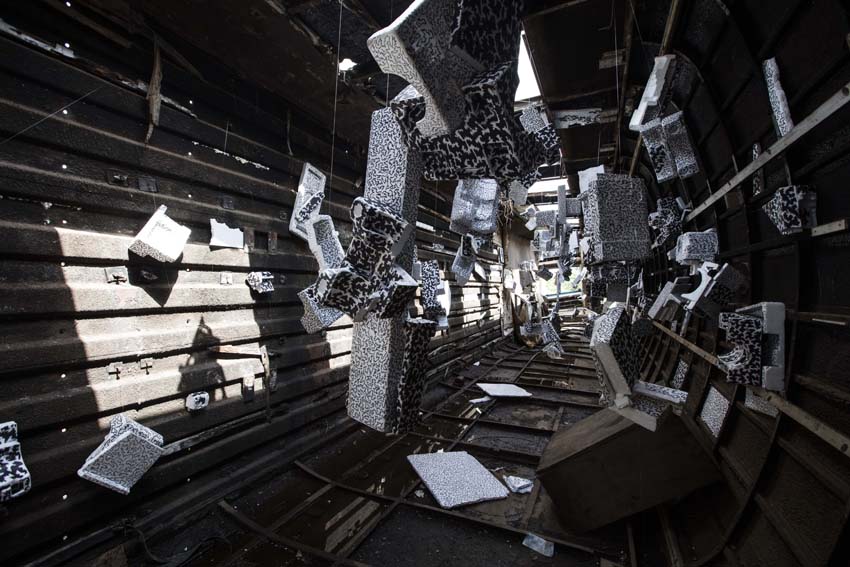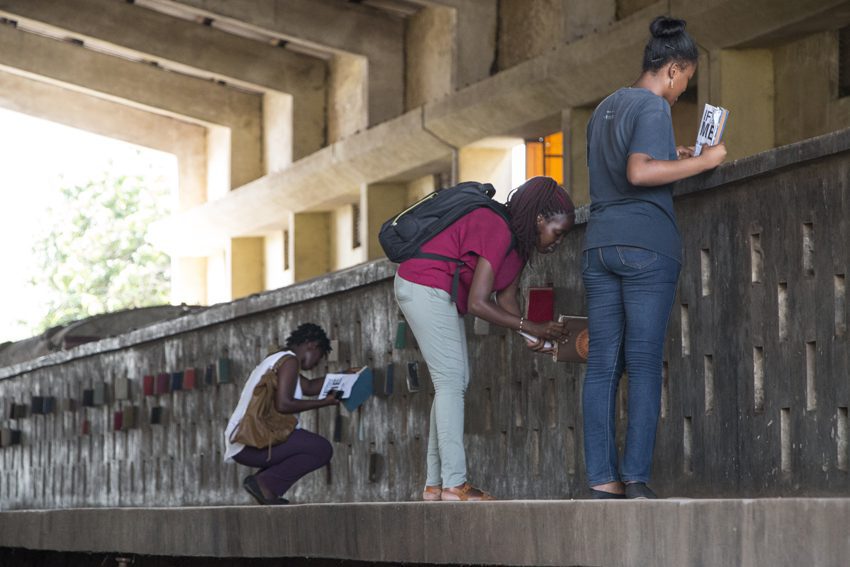Artist Toril Johannessen took a closer look at the show "if you love me..."

Edwin Bodjawah. Untitled. Exhibition view, if you love me... image © Ibrahim Mahama. blaxTARLINES KUMASI
For three weeks in April, the exhibition if you love me… occupied the Ghana Railway Company’s defunct buildings and tracks centrally located in Kumasi. Artists had teamed up with railway workers, residents, and students from Kwame Nkrumah University of Science and Technology (KNUST), to let the site take on another life.
Visiting if you love me…, we are asked to perceive what we see as a living organism. At the Kumasi Loco Shed this organism inhabits a space in which drones, robots, and other motorized mechanisms seem just as natural as plants, masks, fabrics, and performances.

Akinruntan, Rex. Untitled. Fibreglass helmets. Installation view, if you love me…. Image © Deryk Owusu Bempah – blaxTARLINES KUMASI
During opening night, engineering student Lolo Atanley attracts a big crowd as he demonstrates his self-assembled 3D printer. A few meters away, a man wearing one of Rex Akinruntan’s oversized fiberglass helmets, is typing away on an old-fashioned typewriter. The typist is Bernard Akoi-Jackson, who instructs the public to go to the ticket office, the starting point for his performance “Untitled… and if I don’t.” Once there, we are interviewed, fill in forms, wait, and then wait some more. Trapped for hours in absurd and bureaucratic procedures, the performance eventually takes us to Accra, Takoradi, and Domeabra – marked by red road signs 50 meters from the shed. Mimicking and mocking managerial structures, the tone is that of a beautiful but sad play, as we are re-enacting journeys of passengers whose destinies and destinations were truly absurd, complicated and far off.
The audience’s participation as well as conversations across disciplines are also encouraged through a collection of books, dusty and worn, contributed by the regional library. The books occupy holes in the railing structure on one of the platforms, like a library shelf, offering reads for hours while waiting for a train that is expected — or has possibly left a long time ago. The textbooks and reports on topics such as development, politics, economy, and natural sciences are available to be exchanged for the visitors’ own books, facilitating the sharing of knowledge or perhaps offering a system for renewal, as many of the books in the collection are outdated.
.

Arde-Acquah, Lois Selasie. Untitled. Ink on styrofoam. Installation view, if you love me…. Image © Deryk Owusu Bempah – blaxTARLINES KUMASI
.
Another system of distribution is set in motion in the work of Francis Anim-Sakyi. His styrofoam plates and empty soda cans decorated with emblematic black and white patterns are scattered throughout the premises and disseminated by the wind, rain, and the people who make use of them. As these objects mix with debris, others blend in with the environment, making it hard to discern whether they belong there or are placed there to speak as art.
Potted plants are arranged on the platforms and in a pond at the end of the tracks. Stephen Smart Sippah and Caterina Niklaus have cleared the pond and carefully arranged new plants. When asked if the plants are indigenous, Niklaus seems to dismiss the issue as irrelevant. And indeed, the question of origin and belonging is a complex one in a place inhabited by those who come there for temporary shelter.
if you love me… is a collaboration between the residents and new occupants participating in the project. Dorothy Amenuke’s work engages directly in this collaboration. Her reed mattresses hang from the ceiling on one of the lower level platforms. Padded pieces of fabric are stitched on to them, adding comfort to the thin reed, while some of the mattresses were burnt and are falling apart. The mattresses are part of a trade transaction between the artist and the residents, who received new ones in exchange for their used ones. Their old beds have a new function delineating the space for some privacy during the exhibition period.

if you love me…- open library, with contributions from Western Regional Library in Sekondi. Image © Selom Kudjie – blaxTARLINES KUMASI
.
Such procedures of trade, gifting, and repurposing seem to be common denominators in the works of many contemporary Ghanaian artists. Mass fabricated everyday objects with traces of personal use speak the stories of their owners as well as the systems of distribution these objects take part in. This highlights the social and political consequences of production and distribution as well as the consequences of art making itself. The artistic and curatorial strategies at play in if you love me… are closely related to changes that have taken place in the teaching program at the Department of Painting and Sculpture at KNUST over the past decade. The outcome has become increasingly visible for a larger audience through exhibitions such as last year’s Silence between the Lines in Kumasi and the Gown must go to Town in Accra. Through its Emancipatory Art Teaching program, led by kąrî’kạchä seid’ou, the department seeks to create an awareness of the responsibilities that come with making art and with making it public.
In a situation with few spaces specifically defined for art, the use of makeshift spaces for exhibitions, such as the Loco Shed, is one strategy employed for making art public. Large-scale work is another. Adjo Kisser’s monumental billboard on the highway interchange next to the Loco Shed is painstakingly hand-painted, and Edwin Bodjawah’s hundreds of metal sheets with imprints of face masks are laid out inside and next to the shed. Inside it, a railroad car hangs above the ground by massive iron chains. Lois Selasie Arde-Acquah’s sculptures, styrofoam packaging material with ink drawings, are floating in mid-air from nylon strings inside the broken metal structure. Hanging perfectly still, the tilted angle of the railroad car nevertheless suggests movement, yet its direction is not defined as it doesn’t seem to have a front or back. As it appears, it could be crashing towards the floor or taking off into the skies; disconnected from the infrastructure of rails that brought the car there in the first place; finding new paths and futures.
.
“if you love me…” was curated by Robin Riskin, Patrick Nii Okanta Ankrah and Selom Kudjie, and was the first thesis exhibition for the MFA Curating programme at the Department of Painting and Sculpture at KNUST.
.
Toril Johannessen is an artist based in Bergen (Norway). Her practice engages in scientific topics. She was a guest speaker at KNUST.
More Editorial